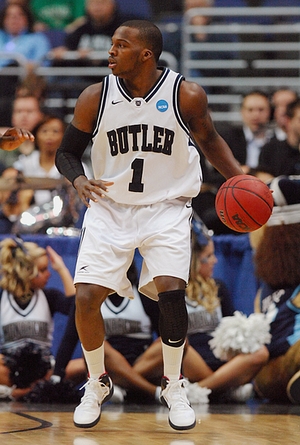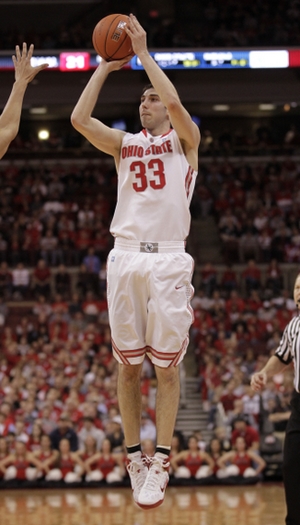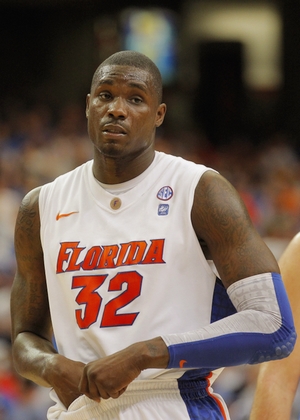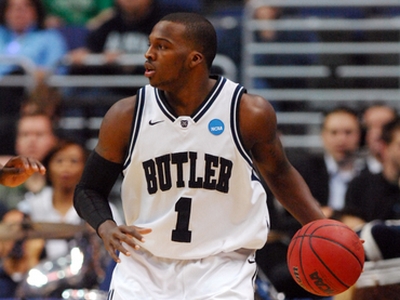Shelvin Mack, 6'3, Point Guard, Junior, Butler
15.9 points, 4.3 rebounds, 3.6 assists, 2.4 turnovers, 40.5% FG, 78.4% FT, 34.1% 3PT

Derek Bodner After a mid-season slump, Shelvin Mack appears to be hitting his stride just in time. Behind terrific games against Pittsburgh and Florida, Mack and the Butler Bulldogs have made another improbable run to the Final Four, even after the departure of Gordon Hayward to the NBA draft last summer.
Shelvin Mack is a 6'3 guard with an NBA caliber frame. He's a strong combo guard, with solid, but not spectacular quickness and average explosiveness. Mack would have good size and strength for the point guard position, but would be undersized if asked to spend substantial minutes at the shooting guard spota position he's often played at Butler.
With the loss of Hayward, Mack was expected to carry a high burden of the scoring load at Butler, an expectation that has come to fruition. Mack is now up to a career best 20.2 points per 40 minute, pace adjusted. His efficiency numbers have taken a significant drop, however, down to 40.5% from the field from 45.4% last year. His efficiency from three has also decreased, to 34.1% from the three point line, down from 39.1%. This is somewhat offset by taking a career high in both three point attempts and free throw attempts, but still ranks him towards the bottom of the pack in terms of efficiency amongst prospects in our top-100 rankings.
This drop in efficiency is more indicative of his changing role than any fundamental difference in his shot. Mack came to Butler primarily getting his offense in transition and as a spot-up shooter during his freshman season. That shot distribution has changed drastically during the past two years as he's shouldered a heavier burden creating in the half court offense. Mack is now getting less of his offense on spot-up and transition opportunities, instead being asked to create off the pick and roll and in isolation situations. In fact, according to Synergy Sports Technology, over 29% of his half court offense is now coming from pick and roll situations, up from 18.7% during his sophomore campaign and 13.3% as a freshman.
Mack's development into primarily being a pick and roll half court guard is part an evolution in his game, and partly because of Matt Howard's development into a perimeter threat. Mack shows a good feel for the pick and roll game, showing an ability to drive to his right off the pick and roll, as well as good patience in waiting for the big to recover to get an open look from deep. Mack has NBA three point range with an ability to hit long distance shots off the dribble.
Mack still plays a large majority of his minutes off the ball, as last year's starter at the point Ronald Nored, as well as Shawn Vanzant, who replaced Nored in the starting lineup earlier this year, share a lot of the ball handling and distribution responsibilities with Mack. Mack gets the majority of his assists off the pick and roll, and off dribble penetration in general, showing solid awareness in the lane and an ability to kick the ball out to spot-up shooters.
That being said, Mack still has a ways to go before proving himself as a pure point, and that's one of the primary questions decision makers will have about him as an NBA prospect. That's not to say Mack is ball dominant, as he gets most of his shots within the confines of Butler's fluid offense.
When looking to generate scoring opportunities for himself in the lane, Mack has good body control when finishing with his right hand, doing a good job of creating space with his left hand while displaying good touch around the rim and showing good change of direction to create space despite his average first step.
Things become a little bit more questionable when driving to his left, as he more often than not tries to finish with his right hand regardless, often times going across his body or into the defender. This shows up when looking at his efficiency, as while he's converting at an above average rate of 1 point per possession when driving to his right, that figure plummets nearly in half to 0.526 when going left. This leaves Mack much more likely to settle for a contested jump shot when going to the left rather than going all the way to the basket, opting for low percentage contested jump shots, while not getting to the line much in these situations.
Mack does have a variety of floaters, step backs, and pull-up jump shots he uses when getting into the paint, combating his lack of vertical explosion. Developing a very reliable pull-up jump shot, Mack does a good job of shooting off the dribble and making contested jump shots, showing an ability to come to a quick stop and get good elevation and balance on his attempts.
On the defensive side of the ball, while Butler plays primarily man to man defense, Mack is generally defending the shooting guard position, and often times the small forward position as Brad Stevens plays Nored, Vanzant and Mack together in a three guard lineup regularly. Mack's strength allows him to defend bigger players better than most guards of his size, but this makes it hard to gauge Mack's ability to defend the point guard spot. While not having great lateral mobility, Mack appears to have good length, solid fundamentals and is an attentive defender, but Nored and Vanzant are the primary defenders at the point of attack, more often than not taking the quickest guy on the opposition.
Mack will be in an interesting position this spring. With the combination of a tough out of conference schedule and deep NCAA tournament runs in back to back years, Mack has been in the public's eye for quite some time now, and if he stays for his senior year, he'll be 23 years old by the time of his draft. It's tough to expect him to lead Butler to a third straight Final Four next season, but anything less than that will be a step backwards relative to the incredibly high standards he's set.
That being said, decision makers are likely to have wanted to see Mack playing the point on both sides of the ball for substantially more time, and unless a team was really impressed with his NCAA tournament games against Pittsburgh and Florida, it's hard to be certain of Mack's chances to land in the first round. With Butler set to lose Vanzant, Howard, and Zach Hahn to graduation, that takes away much of Mack's kick out options, and still leaves fellow Junior Ronald Nored in line to receive a good portion of the precious point guard minutes Mack needs to prove himself in the minds of NBA executives.
Josh Harrellson, 6-10, Senior, Center, Kentucky
7.6 points, 8.8 rebounds, .8 assists, .8 turnovers, 1.5 blocks, 61% FG, 60% FT

Walker Beeken
Perhaps no player has been a more pleasant surprise in this year's NCAA tournament than Kentucky's Josh Harrellson. The Wildcats' center was a valuable piece all season, but his increased production in the tournament has been a huge factor in Kentucky's run to the Final Four, as he's averaged almost 15 points and 9 rebounds per game while shooting 76% from the field.
Harrellsona former Junior College recruit--was nowhere near the NBA radar prior to this season after only seeing the floor in blowouts as a juniorplaying just 88 total minutes all year. However, with the departures of DeMarcus Cousins, Patrick Patterson and Daniel Orton to the NBA, and Enes Kanter being ruled ineligible, Harrellson was thrust into the starting center role for the Wildcats. Without much depth at the big positions, he's been able to play through some of his struggles this season, and now he's peaking at the right time, helping his team to victories and catching the attention of NBA scouts.
From a physical standpoint, Harrellson isn't exactly what scouts are usually looking for from an NBA center. At 6'10 and 275 pounds, with a frame that could still use some tightening up, Harrellson has the strength and bulk needed to compete on the interior, and while he is a better athlete than he appears at first glance, he lacks the length and athleticism of a prototypical NBA big man.
Harrellson has earned praise from the Kentucky coaching staff this season for his commitment to improving his conditioning, enabling him to play increased minutes than what was initially expected from him. He'll need to continue to work hard on his conditioning level and maximizing his explosiveness to limit the disadvantages he'd face physically against NBA caliber centers.
On the offensive end, Coach John Calipari has creatively found ways to take advantage of Harrellson by using him in ball-screen actions and dribble handoffs to free his teammates for shots. He's comfortable catching the ball on the perimeter and shows good decision making skills, as evidenced by the fact that he has as many assists as turnovers this season, which is rare for a big man and ranks him 4th amongst all centers in our database in assist-to-turnover ratio.
Harrellson will never be a player who will get many post-up opportunities (only 7% of his possessions this season have been in the post) or really have any plays called for him, but he's been very efficient with his touches, scoring over 1.1 points per possession on the season, and shooting an impressive 61% from the field. He also shows great activity and effort on the offensive glass, grabbing 5.2 offensive rebounds per forty minutes pace adjusted (3rd highest of all centers in our database), and utilizing both hands to finish around the rim on put-backs.
In order to really enhance his appeal to NBA coaches on the offensive end, Harrellson will likely need to prove that he's capable of knocking down mid-range jump shots, which would keep defenders more honest and make him more of a pick-and-pop threat. He's taken less than one jump shot per game so far this season, and has only connected on 28% of those attempts, but he has a decent release and looks to have the potential to be a serviceable mid-range shooter if he puts in the work.
Defensively, Harrellson will always be at a disadvantage athletically, but he does his best to overcome some of his limitations by playing with a great motor and being extremely physical. He stands his ground in the post and makes it difficult for players to establish post position. Once they have the ball, he continues to fight hard and challenge shots and generally shows good instincts. His average length compared to NBA centers will be an issue though, as will his lack of lateral quickness when defending pick-and-rolls and having quicker big men face him up.
While Harrellson will need to continue to perform in the pre-draft process to hear his name called this June, his play in the tournament has solidified him as a player that NBA scouts need to seriously evaluate. Teams are always looking for extra size, and Harrellson's motor, toughness, passing, rebounding ability, and production at the highest level of college basketball will earn him plenty of looks this summer as teams look for extra big men to fill out their roster.
Jon Diebler, 6-6, Senior, Shooting Guard, Ohio State, 12.6 points, 2.6 rebounds, 2.4 assists, 0.9 TO, 1.0 steals
50.7% FG, 50.2% 3FG, 81.0% FT

Kyle Nelson
Ohio State shooting guard Jon Diebler has been one of the best shooters in college basketball throughout his four-year career. In fact, Salim Stoudemire is the only comparable player in our database (which dates back to 2001) to record a similarly prolific season as a shooter.
At 6'6, Diebler has good size for an NBA wing player. His skinny 200-pound frame and average wingspan, however, leave much to be desired from a physical perspective. He is just an average athlete, as well, lacking ideal quickness and explosiveness for his position.
While Diebler's physical profile is less than impressive, he ranks as one of the most efficient players in college basketball over the last decade, ranking #1 in True Shooting Percentage and points per possession.
Diebler's efficiency stems primarily from the role he plays and his acceptance of his function in Ohio State's offensefor which his skill-level is perfectly tailored. Over 40% of his offensive possessions come in the form of spot-up jump shots, and Diebler converts an outrageous 50% of 7.2 three-point field goal attempts per 40 minutes pace adjusted. As one would expect, his mechanics are flawless, he elevates well, and he is nearly automatic in rhythm. Furthermore, he is just as effective shooting with or without a hand in his face, thanks to his solid size and quick release.
Though he attempted just a handful of shots each game inside the arc this season (1.9 2-point attempts per 40 minutes pace adjusted), he made 52.5% of these looks and continued to show improvement as the year moved on. Though his first step is subpar, he looked more comfortable putting the ball on the floor as a senior, understanding how to pick and choose his spots when opponents close out on him too aggressively. He is a poor finisher, however, due to his lack of explosiveness and strength and he struggles to finish with contact. Furthermore, he gets to the foul line just 2.5 times per 40 minutes pace adjusted.
Diebler will not be responsible for much outside of his shooting prowess at the next level and his skill set situates him well for a career as a role playerala Kyle Korver or Jason Kapono. He has solid court vision and he is an unselfish player. He rarely makes bad decisions either, representative in his absurdly low 1.1 turnovers per 40 minutes pace adjusted, and terrific 2.5/1 assist to turnover ratio.
One significant obstacle to his professional potential, however, is his defense. While Diebler actually seems to possess decent fundamentals and works hard in Ohio State's team defense, he struggles against more athletic players. As was clear in the final game of his college career in the NCAA tournament against Kentucky, he simply lacks the lateral quickness or strength to stay in front of NBA-caliber athletes. This will likely be the biggest question marks scouts have about him, and something he will need to address in private workouts.
Diebler's future at the next level is highly dependent on the situation he's placed in, and the willingness his future coaching staff will have for utilizing his strengths while masking his weaknesses. If recent history is any indication (see the shorter and inferior shooting Andy Rautins, drafted in the early second round last year), however, then he has a legitimate chance of getting drafted. It will be up to him to prove to scouts at the Portsmouth Invitational Tournament and in private workouts that he can contribute on both ends of the floor at the next level.
Vernon Macklin, 6-10, PF/C, Senior, Florida
11.6 points, 5.4 rebounds, 1.7 turnovers, 59% FG, 45% FT

Joseph Treutlein
Five years and one school transfer after entering college, former McDonald's All-American Vernon Macklin finally started to show some consistent ability as a fifth-year senior. Steadily improving his production each of his seasons in college, Macklin saved his best for last with a career-high 25 point performance in an Elite Eight loss to Butler.
Possessing good physical tools for a PF/C at the next level, Macklin has excellent length and a wiry strong frame, while he possesses more than enough fluidity and explosiveness for a player his size. Vastly improving his feel for the game over his time in college, Macklin now has a few skills he relies on frequently to go along with his raw abilities.
On the offensive end, Macklin has undergone a dramatic role change over the course of his college career, initially having little in the form of individual offense, but now seeing over 55% of his half-court shot attempts come in the form of back-to-the-basket possessions. He has a limited arsenal of post moves, but he shows pretty good footwork and feel on the few moves he does use, being very effective with his right-handed hook shot in particular.
His length and mobility allow him to get good separation on his hook shot, but he's highly reliant on turning left shoulder and even more so on using his right hand, while his overall polish on the other few moves in his arsenal are lacking. Teams will be unlikely to rely on Macklin as a post-up threat at the next level given his late development and lack of polish, but having his one go-to move is a nice luxury to have.
The rest of Macklin's offensive contributions come in the form of finishing around the rim on off-ball cuts, pick-and-rolls, and offensive rebounds. He shows good mobility and decent hands on these types of plays, while he's capable of finishing with power around the rim. His feel for the game in reading the floor has also developed significantly over his time in college.
The biggest area Macklin is lacking on the offensive end is having any semblance of a mid-range jump shot, attempting only four jumpers on the year according to Synergy. His free-throw percentage is an abysmal 45% and has been below 50% in three of his four college seasons. This noticeable void in his skill set will may tough to overcome for a role player at the next level.
Defensively, Macklin has very good tools for being an inside-out defender, and shows solid flashes in all areas but is still somewhat behind in fundamentals and feel. He often looks like a fish out of water defending pick-and-rolls, though he has all the length, mobility, and change of direction ability to develop into a good defender there in time. He looks a little more comfortable moving laterally in isolations, where he should be able to respectably defend power forwards with some work.
In the post, Macklin does a great job using his length to contest and is pretty active and focused in general, but he doesn't show the greatest fundamentals and doesn't get as good of leverage as he could, often giving up position and not playing to his potential.
On the glass, Macklin has improved his per 40 pace adjusted rebounding every single season, but has still only topped out at an extremely poor 9.0 per 40 pace adjusted this season. He's better on the offensive than defensive end, but for a scrappy, off-ball role player with no jump shot, Macklin will need to continue improving in this area to have a long term chance. He currently ranks amongst the worst prospects at his position as a defensive rebounder, which will surely be viewed as a glaring weakness.
Looking forward, Macklin did himself a great service by having his best offensive performance in the final game of his career when the most NBA scouts were watching, but his advanced age of 24 combined with his modest production and skill set could put him at a disadvantage in this draft. That said, his learning curve and physical tools could lead someone to take a chance on him, and big bodies with a pulse will always get multiple opportunities to catch on in the NBA in the long term.
Macklin has a good chance to showcase himself in front of NBA scouts at the Portsmouth Invitational Tournament next week, which also happens to be his hometown, and could definitely find himself in second round discussions if he continues to impress during the pre-draft process.







































Comments